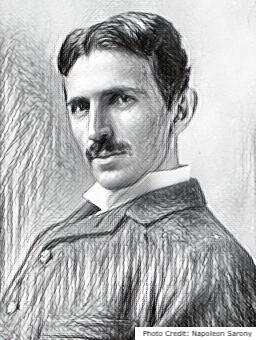Nikola Tesla
Nikola Tesla was a well-known Serbian-American inventor, electrical engineer, and mechanical engineer who was awarded about 300 patents for his inventions. He was born in Smiljan, Croatia on July 10, 1856. Tesla’s mother, Duka, was an early inspiration to him as she invented small household appliances during his childhood. Tesla clearly inherited his mother’s inventive spirit, as he went on to develop some of the most important inventions in history, such as alternating current (AC) electricity and the Tesla Coil.
Growing up, Tesla studied in various places in Europe including Germany, Austria, and Prague. In the late 1870s, he had the opportunity to go to Budapest where he worked at the Telephone Exchange. While in Budapest he made improvements to some inventions and came up with his idea for the induction motor, which produced an alternating current system and used electromagnetic induction from the magnetic field, instead of electrical connections to the rotor. He later tried to gain attention for his proposed invention but didn’t gain any recognition. At age 28, in 1884, he decided to move to the U.S. where there were more opportunities. While in the U.S. Tesla met Thomas Edison and worked alongside him for a couple of months. When Edison refused to pay Tesla for his work, Tesla decided to leave and pursue his own journey as an inventor.
In 1887, Tesla received funding to start a company from American entrepreneur George Westinghouse. Tesla was able to finalize his induction motor to compete against Edison’s direct current system. Tesla’s motor was certainly an asset during the Industrial Revolution of the 19th century as it was found to be more durable, cheaper, and more efficient than his competitors. Tesla licensed his invention to the Westinghouse Company in 1888. In 1893, Tesla achieved a milestone at the World’s Columbian Exposition in Chicago. This exposition was the turning point for public acceptance of alternating current as it dispelled the public’s doubts about the safety and reliability of alternating current. . The exposition demonstrated that alternating current could run smoothly and it later became the main standard for power systems.
In 1895, Tesla’s lab burned down in New York, which destroyed most of his work including notes, designs, patents and inventions. After the trauma of losing everything, Tesla moved to Colorado Springs. During this time, Tesla thought of the idea of a world-wireless-network for communication. He was able to network with J.P. Morgan, a wealthy financier, and together they set up a laboratory back in Long Island, New York.
In 1901 another famous inventor, Guglielmo Marconi, transmitted Morse code from England to Canada, but Tesla believed that Marconi stole some of his world-wireless-network ideas. The following year, Tesla proposed a different angle of communication and came up with the “World Telegraphy System,” in which he envisioned transmitting stations would collect and broadcast news stories through individual receivers. However, this early idea of radio was shut down and Tesla lost the funding from J.P. Morgan that supported his lab because his idea didn’t seem feasible. Investors started to favor Marconi because of his previous success and began funding him instead.
Tesla’s last living years were spent in poverty until he died on January 7, 1943. Six months after his death, the United States Supreme Court awarded the patent of radio back to Tesla. The reason for why the U.S. revoked Tesla’s patent for radio in the first place is debated, but many assume it is because of Marconi’s robust financial backing. . Although the last of Tesla’s years were tragic, he is remembered as an accomplished inventor who made significant advancements in the world of communication, electricity, and manufacturing.


